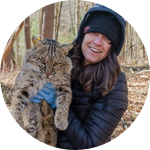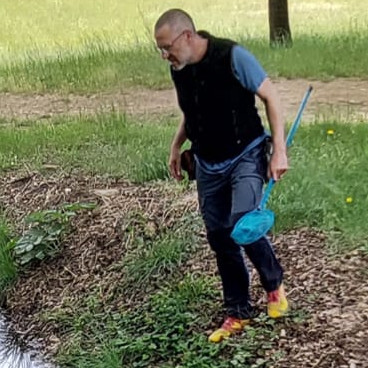About This Project
Habitat degradation has reduced wildlife persistence at multiple temporal and spatial scales. Tropical Andes are biodiversity hotspots and encompass critical areas for ecosystem services provision, but also exhibit high rates of land conversion. We will assess the effects of human disturbance in the extinction probability of the Mountain tapir and Andean bear populations in the eastern Andes of Ecuador. We will identify anthropogenic drivers of land-use change and assess the species’ responses.
Ask the Scientists
Join The DiscussionWhat is the context of this research?
Human land-use change is the primary driver for habitat disturbance, leading to losses on local biodiversity and decreasing the overall species' persistence. Accordingly, two contrasting but interrelated processes result, habitat loss and fragmentation, depicting the removal and spatial configuration of the habitat, respectively. Theoretical studies state that fragmentation effects become apparent when ca. 70% of the habitat area has been removed. So, the wildlife population's persistence depends on population dynamics, habitat availability, and conservation management promoting habitat connectivity.
Our project will be carried out in the Llanganates Sangay ecological corridor, a human-dominated landscape between two protected areas in the eastern Andes in Ecuador.
What is the significance of this project?
Tropical Andes encompass areas of unique biodiversity and are critical for regulating regional climate, carbon storage, and maintaining water supply across the region. However, human disturbances are detrimental to their conservation. Umbrella species, like the mountain tapir and the Andean bear, are critical to identifying well-preserved habitats and ecosystem services. Thus, assessing the effects of land use on the target species extinction probability allows for reducing human threats, managing wildlife habitats while conserving other species living in those habitats. Also, the spatial and multitemporal analyses, like those we will apply, will contribute to informed decision-making in land management in the mid-term, taking advantage of feasible scientifically-informed tools.
What are the goals of the project?
We will investigate the effects of land-use change on the extinction threshold hypothesis in different time frames in the Llanganates-Sangay ecological corridor in Ecuador (CELS). We will conduct a wildlife sampling combining camera traps, line-transect surveys, and non-invasive genetic sampling to record the species occurrence and identify critical areas for habitat connectivity. We will conduct genetic analysis to identify functional connectivity between local populations of the species. We will apply spatial analysis using time-series of satellite imagery to identify past trends in land-use change and, based on socio-economic drivers and land management policy, forecast the effects of different land-use change scenarios in the species extinction probability for the mid-term.
Budget
The funds will contribute to achieving partial goals for our project. Overall, our project includes wildlife sampling, spatial analyses, and landscape genetics to assess the species' occurrence, genetic connectivity, and ultimately, the extinction threshold hypothesis for the local populations of target species. The funds will cover the expenses of the 1st-year fieldwork campaigns, starting from June to December 2022. The funds will be used to cover travel costs, logistics, transportation, accommodation, food, and supplies during fieldwork. We will assign part of the budget to hire local assistants for wildlife and genetic sampling. However, most of the funds will be used for acquiring supplies for genetic analysis and shipping expenses to transport the samples.
We have additional funding from the University of Porto - BIODIV Programme (equipment and travel expenses), Ecominga Foundation (equipment and logistics), and support from the private stakeholders in the study area.
Endorsed by
 Project Timeline
Project Timeline
We will sample 65 1km2 cells within CELS. We will deploy one camera trap active for 60 days and conduct 2 line transects within each cell. We will look for wildlife tracks, feces, hairs, and any non-invasive biological sample to perform genetic analysis.
We expect fieldwork campaigns will take 30 days.
After fieldwork, we will process the field data and get the exportation permits to transport the samples collected.
We will perform the genetic analysis at the University of Porto - CIBIO labs.
Apr 20, 2022
Project Launched
May 30, 2022
Travel from Quito to Baños
Jun 03, 2022
Sampling teams and equipment set-up
Jun 06, 2022
Begins of the fieldwork campaign (Camera trap deployment, line-transect survey, and collection of genetic samples)
Jul 05, 2022
End of the fieldwork campaign
Meet the Team
Gorky Ríos Alvear
https://www.researchgate.net/p...
I am a biologist from Ecuador. I am interested in conservation biology and spatial ecology. I have taken part in the study of small to large-size vertebrate species across several regions in Ecuador, with particular emphasis on the study of keystone mammal species in the central Andes. I have a Master's degree in Conservation Biology and I am currently pursuing my PhD in Biodiversity, Genetics, and Evolution at the University of Porto in Portugal.
I am convinced that science must address the threats to biodiversity conservation by reducing the effects of human disturbance, involving local people at the time to encourage the sustainable management of natural resources. I am sure this project will be useful for land management decision-making and reduce human disturbances over wildlife in a landscape where economic activities depend mainly upon natural resources.
Neftalí Sillero
I am a spatial biologist from Spain but I work in Portugal since 2003. I am interested in the analysis and identification of biological spatial patterns, from species distributions to populations and individuals, using GIS, Remote Sensing, Ecological Niche Modelling, and Spatial Statistics. My main research lines are related to Earth Observation, spatial ecology, biodiversity modelling and conservation, road ecology, and distribution atlases. I use amphibians and reptiles as main species models, but I work also with other groups of flora and fauna. Since 2007, I am the Chairman of the Mapping Committee of the Societas Europaea Herpetologica, where I coordinate the Atlas of Europe. I am currently PI of the MontObEO project, the Montesinho Biodiversity Observatory: https://montobeo.wordpress.com. In 2020 and 2021, I was included in the list made by the Stanford University of the top 2 per cent of the most-cited scientists in various disciplines.
Pedro Monterroso
I have been passionate about the natural world and about the ecology of predators from tender age. The long hours spent reading about wild animals and watching documentaries nurtured a curiosity to learn more about wildlife ecology, which naturally led me to pursue an academic degree in biology at the University of Porto, and to develop a professional career investigating the ecology and conservation biology of terrestrial mammals.
Currently, I am a Wildlife Ecology researcher affiliated with CIBIO-InBIO, University of Porto. My research is strongly routed in the “one earth” vision that humanity and nature can coexist and thrive together.
The intricate link between land use by humans and by wildlife echoes on biodiversity levels and on the nature of human-wildlife relationships, while influenced by large-scale patterns such as climate change or deforestation. Under this vision, I focus my research in understanding the mechanisms shaping the spatial and temporal biodiversity patterns, the structure of wildlife communities, and how they affect (and are affected by) human population. These topics are integrated through the use of new technologies, molecular methods and cross-disciplinary approaches into unified analytical frameworks to efficiently tackle ecological problems.
Using knowledge promotion, training, and integration as key forms of intervention, I have found in conservation science the tool through which I can best contribute to the preservation of our ecosystems and quality of life in general. Hopefully, my modest contribution may serve to make our planet a better place.
Lab Notes
Nothing posted yet.
Additional Information
We are convinced that by promoting the engagement of local people, either by creating working opportunities or by involving them in projects that raise awareness of their livelihoods and resources, we encourage people to protect biodiversity.
Project Backers
- 3Backers
- 2%Funded
- $50Total Donations
- $16.67Average Donation



